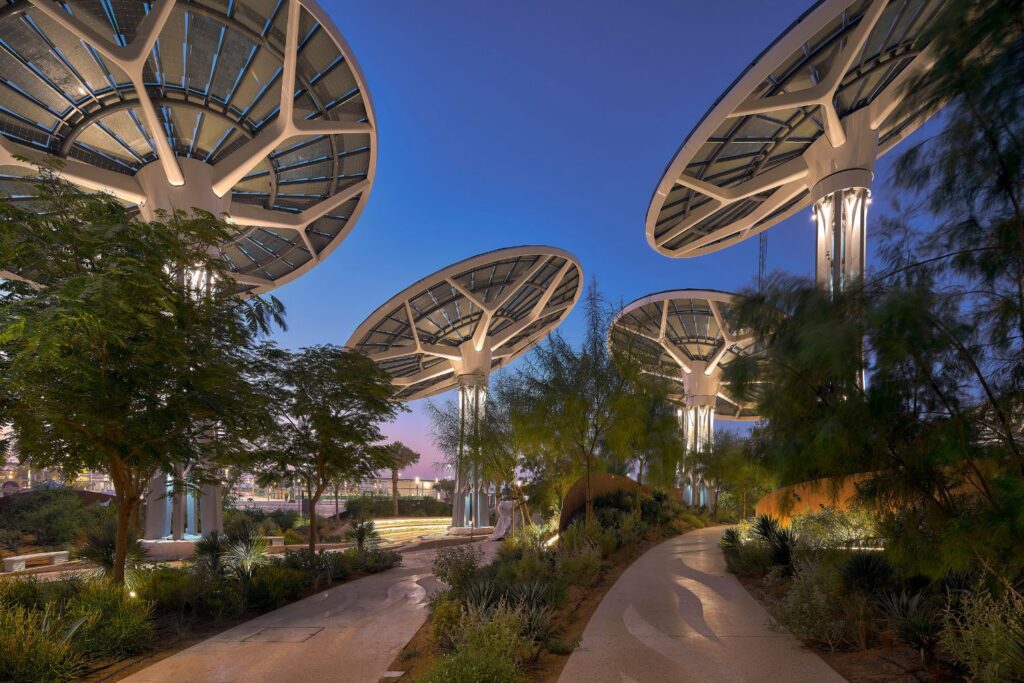Decarbonising our projects
We recognise that the work we do as engineers and consultants has long lasting implications for the ability of our clients to meet their own net zero goals and to realise long term value from their assets. Change is not only necessary, but possible.
What are our project goals?
Our aim is to help our clients make strategic decisions and turn commitments into action through a combination of consultancy and design. Our approach to net zero carbon includes creating clear pathways, developing strategies for masterplans and campuses, and innovative designs for new builds, refurbishment and infrastructure projects.
In 2019 we set two strategic aims for our portfolio of design projects:
Design all new build projects to be net zero carbon in operation by 2030
Reduce embodied carbon intensity of all new buildings, major retrofits and infrastructure projects by 2030.
What are we doing to achieve our project goals?
Through its work with the C40 Cities Climate Leadership Group, our sustainability team plays a critical role in supporting some of the world’s leading cities to reduce their carbon footprint.
We have also been producing portfolio-wide decarbonisation strategies and plans for some of the world’s largest institutional investors and real estate funds, as well as major owner-occupiers such as universities and corporations.
Through practice-wide engagement, we are in the process of creating a routemap to net zero, identifying strategies and actions to achieve our 2030 design project goals. This covers three interlocking themes and builds on current or planned short-term actions in each of these areas. These include:
| CLIENTS AND COLLABORATORS | Advocating for industry wide solutions | – UKGBC Advancing Net Zero Programme partnership – Climate Group Concrete Zero founding member – AIA/EGBC/DGNB |
| Engaging clients in strategic conversations | – Exploring the future of sustainable cities through our Urban C:lab programme – Developing long-term, multi-year partnerships with key clients – Developing net zero carbon strategies and pathways across portfolios and masterplans | |
| DESIGN AND CONSULTANCY | Collecting data and examples from current portfolio | – Created central climate emergency knowledge hub – Collecting data on predicted and measured-in use operational energy and embodied carbon for our projects |
| Setting project targets and measuring performance against industry benchmarks for sector/region/typology | – Contributed to establishing industry benchmarks through Green Building Councils, LETI, CIBSE, RIBA, AIA, IStructE and other industry groups around the world – Setting ambitious performance targets for many of our projects and agreeing those with our clients | |
| BUSINESS PROCESS | Tracking progress through Project Environmental Checklist and Building Performance Dashboard | – Capturing qualitative and quantitative data on project alignment with our net zero goals – Dashboards built and available to all staff to assist with transparency across our portfolio |
| Embedding accountability at all levels in the organisation | – Global strategy driven through Global Leadership Team – Responsibility on each regional board | |
| Empowering our people | – In FY 21/22 all UK partners and directors had a sustainability/climate CPO objective and globally, 37% technical staff (490 people, 42 disciplines) had a sustainability or equity CPO objective – Learning and development supported through multiple resources including climate emergency hub |
What have we achieved so far on projects?
We have built the infrastructure to measure alignment of our projects through qualitative and quantitative data and are tracking this on a regular basis. We have collected qualitative data from 430 projects at concept design stage and 296 projects at scheme design stage.
For the applicable projects:
75% of project teams reported that there will be, or already is, a project-specific sustainability policy that sets clear objectives for the project team around the climate and biodiversity emergencies
71% of project teams reported that the client’s ambitions align with the principles and targets set out in the Global Sustainability Report, including net zero in operation by 2030 and 50% reduction in embodied carbon by 2030.
We are planning for the number of applicable projects to increase each year. We have also started to collect quantitative data on predicted and measured energy use intensity (EUI) and embodied carbon intensity of our projects. This will enable us to better understand our existing project portfolio, compare against industry best practice benchmarks and inform the development of new benchmarks for building typologies and regions where these do not currently exist.
Next steps
We recognise internal and external processes and conversations must change, and that the nature and scale of the decarbonisation transition means we cannot do this on our own. We need to act jointly with clients, collaborators, contractors and our supply chain to achieve our goals. At the same time, we need to ensure that our business model remains sound, which in turn enables us to have the appropriate levels of impact.
We will continue to contribute to region and sector-specific industry roadmaps that reflect the roles of different actors necessary to achieve net zero, work with our current and future clients to articulate the sustainability benefits case and seek to set appropriate targets and scopes to deliver these goals.
Through the remainder of FY 2022/2023, our clear intent is to build on the work done so far to create an appropriately funded and resourced implementation plan to execute a routemap to net zero. This will define design project goals and develop a mechanism to regularly share progress and updates internally and externally.
This work includes sharing best practice examples and carrying out more detailed modelling of pathways to 2030. In parallel, we are developing our implementation plan to define clear roles and responsibilities, appropriate funding commitments, prioritised actions and smart objectives.
Further detail will be published before the end of the financial year.
Case Studies

C40 cities clean construction programme
Buro Happold and C40 Cities have launched a series of six ‘Clean Construction’ reports. These reports support cities in resourcing efficient, net zero construction to deliver healthy, resilient and thriving urban communities, via a net-zero-carbon built environment system that tackles the global negative impacts of the construction sector in a just way. The six cities in the series are: Toronto, Canada; Mexico City, Mexico; Milan, Italy; Ekurhuleni, South Africa; Quezon City, Philippines and Qingdao, China.

University of Leeds
Buro Happold’s energy consultants were engaged to help develop the University’s net zero carbon implementation plan. To find out how best to meet the net zero objective, Buro Happold’s energy reduction specialists undertook a technical, commercial and institutional feasibility review of the available pathways. They modelled the net zero pathway to capture data on existing university demands before appraising a series of interventions, such as building retrofits and changes to energy generating technologies.

Santa Monica City Hall East
Santa Monica City Hall East is leading the way in sustainability within new construction. Buro Happold provided integrated engineering and sustainability consulting services for the expansion of the City Hall, resulting in an all-electric, net-zero energy and net-zero water site. Our work demonstrated that the new building is ready to meet Living Building Challenge criteria – the world’s most stringent green building rating system.





